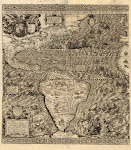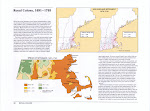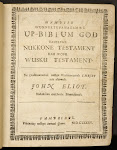Thursday, February 25, 2010
Martha Ballard
1. Martha Ballard's role in society (both as a worker and as a woman) - why is it significant?
2. The basis of Ulrich's evidence and how she uses this evidence to construct a narrative
3. Your impression of the article (Did you enjoy it? Why? Why not? Provide specific examples to explain what you did or did not enjoy about the article).
Thursday, February 18, 2010
Woody Holton on Elites in the American Revolution
Saturday, February 13, 2010
Jonathan Edwards Speaks of Sin and Salvation and Franklin Contemplates Whitefield
Address the following questions:
1. What are the difference between Edwards and Whitefield? (in terms of belief about God, about human nature?)
2. Why are both men so effective? What attracted follows to them (you may need to reference your textbook to effectively answer this question)?
3. How can we identify both of these men as part of the Great Awakening?
4. Why is the Great Awakening important in the "creation" of America?
Thursday, February 4, 2010
Black Robe, The French Empire, and Empires in Conflict
Compare what you saw in Black Robe (particularly the second half of the film - and be sure to use specific details from the film in your post) to what Richter said about the French and missionaries and to what you learned in lecture about the French.
In addition to a few sentences on the topic above, please also be sure to discuss religious practices, the clash of cultures, and rivalries between empires (both European and American Indian).
Saturday, January 23, 2010
Puritan Daily Life and Concerns
This link 1675 diary of a Puritan girl, its author is unknown, appears to begin on her birthday and covers, roughly, a two year period. It was first published in the late 19th century - the link is to the article as it was originally published with text from the diary. Read through the article and text (it's five pages) and then write a paragraph or two about the diary.
What seem to be some of the girl's major concerns? What kind of a "snapshot" of Puritan daily life does it provide? What do we learn about Puritan daily life? How does this account compare to some of your other readings about Puritans and what you learned in lecture about their daily lives and concerns?
Wednesday, January 13, 2010
American Indians and Europeans in the Old New World
Using one of the film clips we watched in class (the links to them are on Blackboard), the chapters we read last week in Facing East, and Cabeza de Vaca’s account of his journey through Florida to the Southwest during the sixteenth century, discuss the ways that Native Americans and Europeans interacted and were envisioned by us and each other.
This doesn’t need to be a long answer – a paragraph or two will do. Just put together a few thoughts about how we think about early American Indian-European relations (with our 21st century perspective in the films), what Cabeza de Vaca says about his encounters with Native Americans (using specific examples from the text); and what Facing East proposes about how Native Americans discovered Europe.
Thursday, January 7, 2010
Introduce Yourself!
This week, we’re set to tackle early contact and European settlement. We’re going to focus in on a much smaller (much, much, much) time frame as we trace some of the initial contacts and struggles colonization created.
As a way of introducing you to the class, and the class blog, I’d like each of you to introduce yourself by creating a list of 10 or so things about yourself. This can range from your major to your hobbies to random facts. One requirement: please do include your name!
10 Things
1.I did my graduate work at The College of William and Mary in Virginia
2.I specialize in nineteenth and twentieth century history and media studies; but, despite this, most of my teaching has been in the colonial and early national periods of American history (William and Mary sits next to Colonial Williamsburg)
3.I also have a strong interest in the way history is presented in popular films and have, in fact, taught a “History by Hollywood” seminar a number of times at The College of William and Mary and Temple University in Philadelphia.
4.I think history matters and can teach us amazing things about our past, our present, and our future.
5.I did my master’s degree at the University of London in England … that’s right- American history in London.
6.I did my bachelor’s degree at the University of California at San Diego. I had a hard time picking a major so I ended up with History, and with minors in Literature and Political Science (and almost one in Third World Studies).
7.I’m a California native and I miss fish tacos in San Diego, Berkeley’s used bookstores, Pacific Ocean sunsets, and the diversified geography of ocean, valleys, and mountains all within a few miles of each other
8.Before I attended graduate school I was a newspaper reporter in California
9.I hate the cold and snow (I know, right? I’m living in Chicago …why?)
10.I’m excited to teach History 181 this semester!
--- SG
Saturday, January 2, 2010
Welcome
From the class syllabus:
Each week, I’ll post a question about one of the primary sources or a new primary source/question or a film clip/question. During the course of the week, but before our class meets, it is your responsibility to respond AT LEAST ONCE about the document in question.
· This Blog will also be used to post interesting items in the news and as a debriefing site after class discussions (i.e. if students – or the instructor – want to continue a particularly fruitful discussion on the Blog, we may).
· Finally, the course Blog will also be used by me to post additional thoughts and comments about the history we’re covering – and for you to respond if you’re so inclined (encouraged; not required). Students may also submit topics for Blog discussions if there is a particular issue or idea they wish to discuss.
· You MUST e-mail me the e-mail address you want to use to access the blog by January 9th. The question for Week I will ask you to tell me a few things about yourself (I’ll do the same) to help us adjust to the technology
If you have a suggestion for the blog or an item you'd like to discuss on the blog - just let me know.
For our first week, I'll pose a series of questions about you that I want each of you to answer (by using the "comment" option after my post) as a way for us to get to know each other and familiarize ourselves with blogging. Those questions will be posted by Saturday, January 9th.
In the meantime, please let me know if you have questions or suggestions!
SG

















